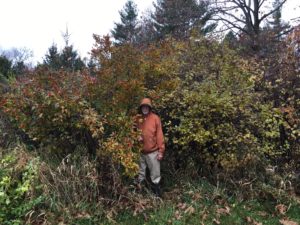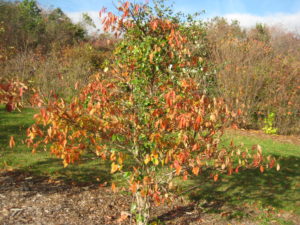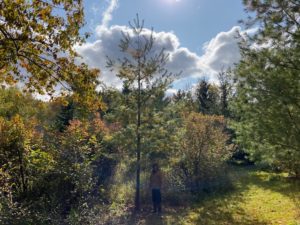Managed Succession
Biologically, the term succession refers to a shift in plant and animal communities over time. For example, if you stop cutting hay in a local alfalfa field, within a year or two you will notice trees and brush popping up, and within a decade the alfalfa will be shaded out and replaced by red cedar, box elder, autumn olive, gray dogwood, and tall herbs like woodland sunflower and oldfield goldenrod.
But instead of being a mere spectator to succession, we can nudge it to go in certain directions, either by killing or handicapping certain species, or by planting or managing for more desired ones. Another option is to plant desirable short-lived species and once they are established, plant long-lived species to succeed them – which is my example today.

One edge of the birdberry thicket, with winterberry immediately behind me. Note the spires of Norway spruce poking up through the thicket in the background.
In 1990 I planted a birdberry thicket in a bottomland hayfield. The new species were highbush cranberry, arrowwood, winterberry, and elderberry. Elderberry is short-lived, individual plants only live a decade or so; the others should be good for 30 or 40 years. So I spaced the shrubs so there was sprawling room between them, and once established, I planted some Norway spruce and white pine between them.
Today, the elderberries are mostly gone and the conifers are above the shrubs and beginning to produce cones and seeds, increasing the food value for the birds and mammals. This also creates better winter shelter for owls, deer, and songbirds. Wild grapes were planted by the birds and help turn it into more of a habitat jungle.
Management today in this patch is mostly a winter exercise with chainsaw and pruners – creating room for the conifers to fill out, and to keep the grapevines from overwhelming the other species.

Using sassafras as a trellis for still green trumpet honeysuckle.
Some of the birdberries will begin dying off during the coming decade. I plan to use them as a trellis for other native vines, perhaps trumpet honeysuckle (see link – Attract Hummingbirds with Native Honeysuckle)

A young wite pine front and center, flanked by highbush cranberry. Norway spruce further back on both sides.
Planting non-natives like Norway spruce and white pine in a native woodland would not be a good idea. But it helps turn land already trashed by agriculture into habitat for native critters.
So far, the world’s nations have done nearly nothing to deflect climate change from its present trajectory. So we could potentially come within the climatic range of purple passionflower and yellow passionflower, two species that in their native range max out northwards in central Missouri, and support a half dozen native butterfly species – which we rarely see here today. But longer, hotter, or more humid summers may not do much to extend their ranges toward us. The real limits are more likely to be the severity of the occasional winter, last winter being an example. See my climate blog series for details:


